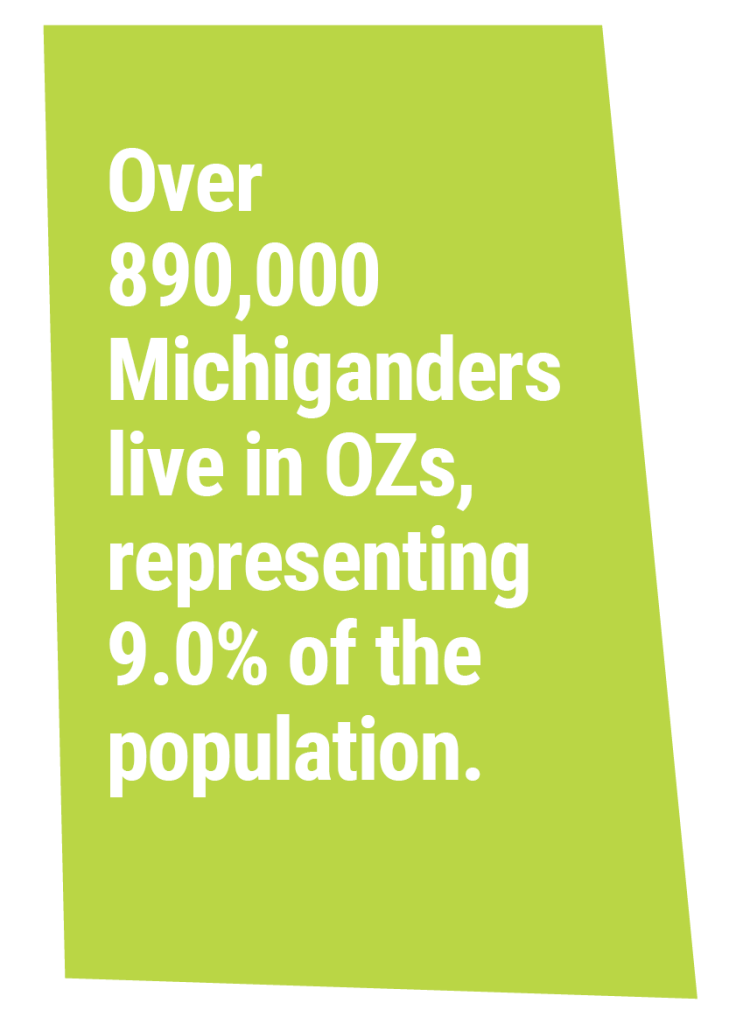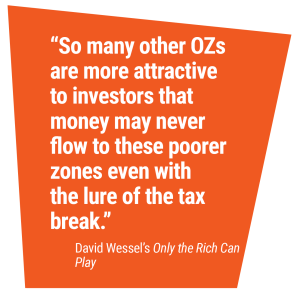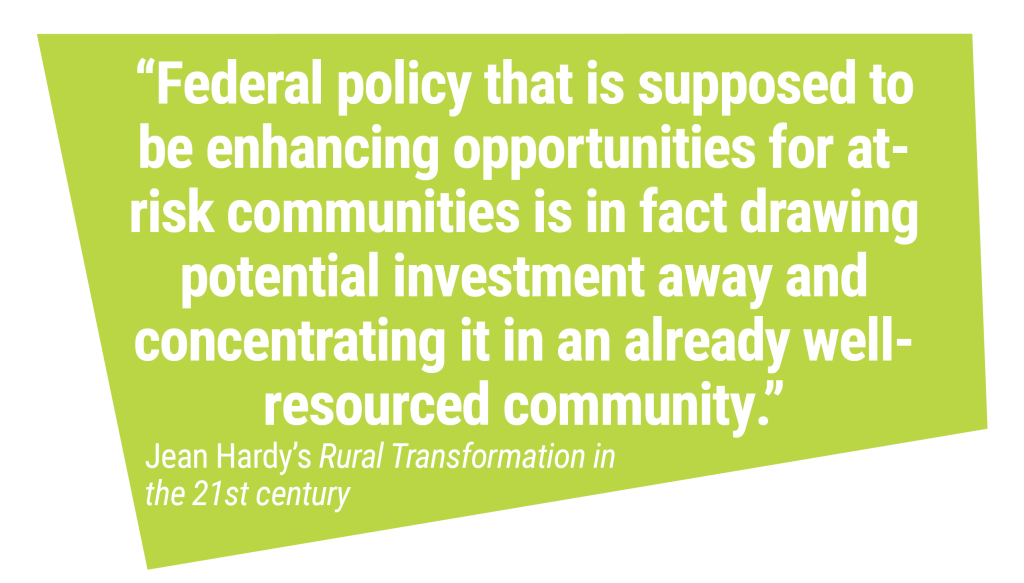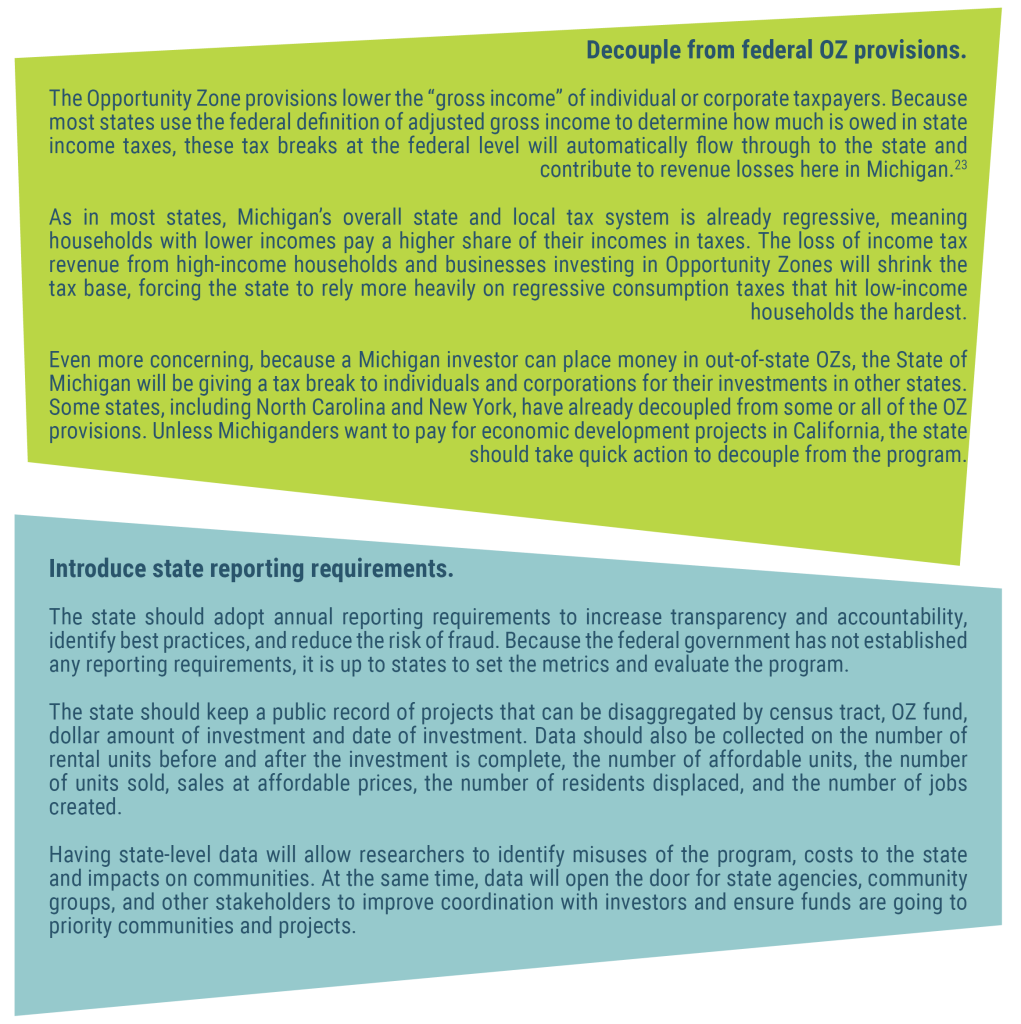Introduced as part of the Tax Cuts and Jobs Act of 2017, the Opportunity Zone (OZ) program is a federal incentive designed to encourage private investment in low-income communities by providing a tax break to wealthy investors.
The OZ program is an example of a place-based policy, meaning the incentive seeks to reduce socioeconomic disparities across geographies. The U.S. has a long history of using place-based policies to address inequities in access to opportunities, such as through Empowerment Zones (1995) and the New Markets Tax Credit Program (2000). Both programs were designed to improve the economic well-being of designated low-income communities–Empowerment Zones by providing tax breaks for hiring workers from the communities and the New Markets Tax Credit by drawing private investment to the communities.
Despite their popularity, the relationship between economic development incentives and good investments is not clear cut. A growing body of research demonstrates how economic development incentives fail to bring new jobs or business development to low-income communities. A 2018 Upjohn Institute study found firms that received tax incentives failed to create more jobs than those without incentives—in fact, employment growth was 3.7% slower in firms with incentives.1 In its research on Michigan’s incentive programs, the Mackinac Center finds the cost per job often exceeds the average annual wage of the job itself.2
Like other place-based policies, the OZ program aims to benefit residents in target communities. Over 890,000 Michiganders live in the 288 OZs across the state, located in nearly every county. While the program has the potential to benefit residents with low incomes living in these communities, loose rules and lack of oversight could accelerate gentrification in some neighborhoods or subsidize investments that bring little or no benefit despite the huge price tag.
These concerns are especially germane to Black and Brown communities, which have historically experienced underinvestment but are still in many ways excluded from decisions about OZ investments. The OZ legislation promises capital investments and new jobs for OZ communities, but the only guaranteed benefits will go to the wealthy, often White, investors whose taxes will be reduced by huge amounts.

The cost of the program is substantial. At the federal level alone, the Joint Committee on Taxation estimates revenue losses from OZ tax credits of $1.6 billion within the first ten years.3 Only four states have estimated their anticipated revenue losses from the program, with estimates as high as $15.9 million annually in future years.4 Although Michigan has not estimated the revenue impact, the state will certainly face additional losses due to its conformity with the federal definition of “personal income,” meaning wealthy Michigan investors taking advantage of OZs, whether in or outside of Michigan, will receive a break on their state taxes as well.
Fortunately, Michigan legislators can take action to protect state revenue and improve transparency about how OZ investments are impacting communities in our state. Michigan should decouple from the federal Opportunity Zone provisions, as a growing number of other states have done, to ensure the state is not subsidizing lucrative investments, including those made in other states. Additionally, the state should require reporting from taxpayers making use of the program so communities can easily identify the type and size of investments being made in their neighborhoods.
The Communities
The U.S. Department of the Treasury used 2011-2015 data from the American Community Survey to select eligible census tracts. A census tract had to meet one of the following criteria to be considered a “low-income community”:
a) A poverty rate above 20%;
b) A median family income less than 80% of the area median (for urban tracts); or
c) A median family income less than 80% of the state median (for rural tracts).
Of Michigan’s 2,813 census tracts, 1,152 tracts (41%) met the definition of low-income communities and were therefore eligible for consideration to become an OZ. Once these eligible tracts were established, the list was presented to Gov. Rick Snyder to choose the final set of Opportunity Zones.
Because the definition of a “low-income community” was broad and not explicitly focused on poverty, governors had wide latitude to make nominations. The law allowed governors to select up to 25% of eligible census tracts as OZs; up to 5% of the selected tracts were not required to be low-income communities as long as they bordered a low-income OZ.
Of those the governor selected, most OZs (70%) were both high poverty and low income based on data available at the time. Some OZs (28%) are either low income or high poverty, while six (2.1%) are neither. Five of these, called “contiguous tracts,” are neither high poverty nor low income but were eligible because they directly border an eligible low-income OZ. One tract earned OZ status due to error or intentional mislabeling, a mistake which is further discussed below. Five of the six high-income, low-poverty tracts are in Wayne County.
Although Governor Snyder did not select the eligible tracts with the highest levels of poverty, Michigan’s Opportunity Zones do exhibit greater need on average compared to eligible but unselected tracts. OZ tracts have smaller and younger populations; a smaller share of White residents as well as a larger share of Black residents; a greater share of disabled residents and a lower share of residents with a high school diploma.
Importantly, median family incomes as well as median home values are lower in selected tracts while poverty rates are higher. Poverty rates across all Michigan census tracts averaged only 19% in the 2015 data, but were 32% in designated OZ tracts. Nevertheless, the state did not select the absolute poorest tracts for inclusion in the program. Of the 100 poorest census tracts in Michigan, only 29% were selected as Opportunity Zones.
Governors across the country were given wide latitude in their selections, leading to accusations of political favoritism in some states. While Michigan saw relatively few instances of overt private influence over the zone selection, a ProPublica investigation found special interests lobbied for the inclusion of several zones in Detroit’s central business district.5
At least one of these tracts was ineligible based on poverty rates, median income, and population, but it was re-classified as a “low-income community” and did indeed become an Opportunity Zone. Follow-up research into this discrepancy showed at least one contiguous tract was made eligible only because it bordered on this reclassified tract, indicating that two OZs in downtown Detroit should not exist based on the stated program rules.6
The Investors
Not everyone can take advantage of the Opportunity Zone tax incentives. The tax credit is only available to individuals with capital gains, which come from the sale of an asset such as property, a business, or an existing investment. In Michigan, two-thirds of capital gains income is concentrated among the top 1% of income earners, those earning over $436,500.
In other words, the Opportunity Zones program is a tax credit for only the wealthiest Michigan residents. Early evidence shows the average household income for Opportunity Zone investors in 2019 was over $4.8 million.7 And for those who do have the right kind of income to participate, the tax savings are substantial.
Individuals or corporations with capital gains can invest this income in a Qualified OZ Fund, of which 90% must be invested in an OZ business or property. While investors will eventually pay taxes on the capital gains from the initial sale, they will never be required to pay taxes on the sale of the OZ investment so long as it is held for ten years.
The Opportunity Zone program offers three types of tax incentives for investors:
Because there is no limit to the number of investors who can participate, nor is there a limit on the amount they are allowed to invest, the potential revenue losses are substantial.
Early Evidence
Early evidence on Opportunity Zones reveals the program has limited impacts for zone residents. To date, researchers have shown that OZs have had no or negligible effects on a number of outcomes, including home prices,8 job vacancies, wages,9 employment rates, and poverty.10 Urban OZs appear to have had some positive effects on employment growth relative to unselected census tracts, driven largely by the creation of new establishments, but this trend did not hold up for rural zones.11
The program’s limited impacts may be explained in part by the high concentration of investments in OZs with relatively higher incomes, home values, educational attainment, and gentrification. Data from paper tax returns is not yet available, but electronic filings from tax years 2019 and 2020 reveal not all OZs are benefiting from the program. Opportunity Zones in the Detroit metro area have received a relatively large amount of investment through the program at nearly $5,000 per resident, but approximately 40% of designated zones in the city did not receive any investment. Across the country, the majority (63%) of OZ tracts received no investments in the first two years.12
not all OZs are benefiting from the program. Opportunity Zones in the Detroit metro area have received a relatively large amount of investment through the program at nearly $5,000 per resident, but approximately 40% of designated zones in the city did not receive any investment. Across the country, the majority (63%) of OZ tracts received no investments in the first two years.12
While Michigan generally succeeded in selecting Opportunity Zones from communities with the greatest need, this evidence suggests being a designated OZ does not guarantee interest from investors. These results demonstrate what early critics of the program warned: investors will choose the most attractive sites for development over those with the greatest need.13 Because investors have the choice to fund projects in relatively high-income, low-poverty OZs, there is no incentive to instead invest in the areas with the highest need.
Problems with Opportunity Zones

The program may exacerbate racial inequities.
Poverty exists and persists in Black and Brown communities in part due to the inequitable policies and institutions—including segregation, redlining and predatory lending—that maintain racial wealth and income disparities. The OZ program attempts to address racial inequities by attracting wealthy outside investors rather than investing in the people and businesses already living there.
Although we know little about the investors taking advantage of the program, we do know Opportunity Zones primarily benefit the richest Americans, who are disproportionately White. Opportunity Zones funds are often only open to “accredited investors,” which requires the individual or corporation to have a minimum income of at least $200,000 in the past two years and a net worth over $1 million (excluding the primary residence). Few Americans have this level of wealth, and in 2020, less than 5% of households in Michigan with incomes over $200,000 were Black.14
In addition to the direct ways in which Black and Brown Michiganders are not able to take advantage of the program as investors, the state revenue losses will divert resources away from schools and public services that benefit communities of color. State and federal tax dollars intended to fund child care, job training programs, and other essential services that promote opportunity will instead go to very wealthy, predominately White investors.
Rather than working to convince wealthy investors of the value of bringing capital to low-income communities of color, Michigan needs policies that invest directly in these communities and their local businesses.

There is a mismatch between investor wants and community needs.
Within Opportunity Zone communities, investors have little incentive to invest in businesses or projects that reflect the interests of residents. Opportunity Zone funds can be invested in real estate developments as well as directly into new or existing businesses, but research so far suggests the majority of OZ funding is typically directed towards commercial real estate investments. Smart Growth America found the design of the program prevents it from attracting investments to minority-owned small businesses or legacy businesses owned by community members.15
 From the investor perspective, real estate generally offers larger, more predictable projects with a higher rate of return. From a small business perspective, owners often prefer debt over equity financing and can find the rules and regulations around the new tax incentive difficult to understand. The mismatch between OZ investor and OZ business interests reduces the potential impact of the program.
From the investor perspective, real estate generally offers larger, more predictable projects with a higher rate of return. From a small business perspective, owners often prefer debt over equity financing and can find the rules and regulations around the new tax incentive difficult to understand. The mismatch between OZ investor and OZ business interests reduces the potential impact of the program.
This mismatch is perhaps most obvious in rural communities, where investment opportunities rarely have the high rate of return or fast growth investors seek. Research suggests Opportunity Zones are “incompatible” with rural development, both because of the program’s failure to consider the needs of rural communities and its focus on growth rather than long-term sustainability.16 It comes as no surprise that the Michigan Opportunity Zones Office, coordinated by the Michigan State Housing Development Authority and the Michigan Economic Development Corporation, has no examples of rural investments on its website, and it remains unclear if any rural zones in Michigan have managed to attract OZ investment.

States are subsidizing investments that would have occurred anyway.
A longstanding criticism of economic development incentives focuses on the very small role of tax breaks in firm location and investment decisions. A review of 30 studies found at least 75% of firms benefiting from economic development tax breaks would have made similar investment or location decisions even without the incentive.17
The structure of the program assures many of the resulting investments would have been made even without the tax breaks. While no data exists to show what share of projects had already begun before the new tax credit was passed, David Wessel, senior fellow at the Brookings Institution, found numerous anecdotal examples nationwide of developers investing OZ funds in buildings that were already complete or nearing completion.18
Because the size of the OZ tax break increases with the return on investment, investors are incentivized to seek out projects that are the least risky and would already attract investors even without the OZ designation. There is no added benefit to the investor of selecting an affordable housing project with a large social impact over a luxury housing development in a rapidly growing neighborhood. In fact, the return to the investor will almost certainly be greater in the latter case.
Some tracts likely to attract investors without the Opportunity Zone designation include areas around colleges and universities. These areas qualify as low income because large concentrations  of students skew the income data, but they are often attractive to developers who can take advantage of a guaranteed market of reliable renters. In Michigan, 21 colleges and universities overlap with an Opportunity Zone, including Wayne State, Northern Michigan and Eastern Michigan.
of students skew the income data, but they are often attractive to developers who can take advantage of a guaranteed market of reliable renters. In Michigan, 21 colleges and universities overlap with an Opportunity Zone, including Wayne State, Northern Michigan and Eastern Michigan.
Other tracts likely to attract investors even without the OZ designation include those in stadium districts. All three major sports venues in Detroit—Comerica Park, Little Caesar’s Arena and Ford Field—are in designated Opportunity Zones. Similarly, stadium districts in Lansing and Midland fall within OZ tracts. While tracts like these represent just a small share of OZs, investors will prefer to invest in zones like these compared to those with low levels of existing development. Nothing about the OZ legislation prohibits it.
In Lansing’s stadium district, investors took advantage of OZ tax breaks while developing a mixed-use building with an upscale grocery store, above-market rental units and a hotel.19 A two-bedroom apartment here begins at $1,915 (as of May 2022).20 Based on HUD guidelines, this unit would only be “affordable” for someone earning $76,600 annually, which is far above the median family income of less than $50,000 in its census tract. Nothing about this development is against the rules of the program. While the stated intent of the Opportunity Zones legislation may have been to encourage growth and investment in low-income communities, developers are not obligated to make this a priority.

Many Opportunity Zones were already experiencing high levels of socioeconomic change.
When a traditionally low-income neighborhood is gentrifying, it attracts more wealth and investment at the expense of existing residents, who often find themselves priced out. Critics of place-based economic development policies have long worried how tax incentives could serve to displace the exact communities they seek to help, and Opportunity Zones will have these same negative impacts if they drive investments to tracts already experiencing socioeconomic change.
When OZ legislation passed in December 2017, eligibility for the program was based on the already outdated 2011-2015 American Community Survey (ACS) data. Because Michigan was still recovering from the Great Recession, many eligible census tracts were undergoing high levels of socioeconomic change during this time. Despite having the largest reduction in the unemployment rate of any state from 2010 to 2011, Michigan’s unemployment rate was still significantly higher than the U.S. average.21
A national Urban Institute study reviewed the number of OZ census tracts between 2000 and 2016 to assess whether the program is encouraging investments in communities already experiencing high levels of socioeconomic change. Compared to eligible but unselected tracts, OZ tracts in Michigan were 3.5 times more likely to have experienced high levels of socioeconomic change during this time period.22
As a result, many of the tracts that met the income and poverty criteria when zones were selected are no longer considered economically distressed. Only 56% of Opportunity Zones in Michigan were considered both high poverty and low income in 2019 compared to 70% when the zones were initially selected. The number of OZs considered “high poverty” shrunk by over 18 percentage points by 2019 when the first investments began flowing into communities.
Because the designated OZ tracts are fixed, the state cannot update eligible tracts to better target truly disadvantaged communities. Investors will continue to receive outsized benefits for investments in these 288 Opportunity Zones through 2028, even as the number of high-poverty tracts shrinks.
Policy Recommendations
Because Opportunity Zones are part of a federal program, the state is limited in its ability to change or improve its administration. Nevertheless, Michigan can take action on the two policy recommendations made below.

Over 97% of counties received at least one OZ, including 100% of counties with eligible tracts. The two counties without any Opportunity Zones, Benzie and Leelanau, did not qualify due to low poverty rates and relatively high median family incomes.
End Notes
1 Mary Donegan, T. William Lester, and Nichola Lowe. “Striking a Balance: A National Assessment of Economic Development Incentives.” W.E. Upjohn Institute for Employment Research, 2018. https://doi.org/10.17848/wp18-291.
2 Michael D. LaFaive, Srikant Devaraj, and Michael Hicks. “Economic Development? State Handouts and Jobs: A New Look at the Evidence in Michigan.” Mackinac Center for Public Policy, 2020. https://www.mackinac.org/archives/2020/s2020-05.pdf.
3 Estimated Budget Effects of the Conference Agreement for H.R. 1, the ‘Tax Cuts and Jobs Act.’” Joint Committee on Taxation, December 18, 2017. https://www.jct.gov/publications/2017/jcx-67-17/.
4 Good Jobs First. “States Are Losing Revenue Passively to Federal Opportunity Zones. But Only Four Have Even Estimated Their Losses.” 2022. https://www.goodjobsfirst.org/blog/states-are-losing-revenue-passively-federal-opportunity-zones-only-four-have-even-estimated#:~:text=Subsidy%20Tracker-,States%20Are%20Losing%20Revenue%20Passively%20to%20Federal%20Opportunity%20Zones.,billion%20between%202018%20and%202027.
5 Jeff Earnsthausen and Justin Elliot. “How a Tax Break to Help the Poor Went to NBA Owner Dan Gilbert.” ProPublica, October 24, 2019. https://www.propublica.org/article/how-a-tax-break-to-help-the-poor-went-to-nba-owner-dan-gilbert?token=r1lj90AOnclNHz78Mel_3jAWvczxarxk.
6 Robert Orr. “These Opportunity Zones Shouldn’t Exist — Scandal or Innocent Mistake?” Niskanen Center, November 4, 2019. https://www.niskanencenter.org/these-opportunity-zones-shouldnt-exist-scandal-or-innocent-mistake/.
7 Patrick Kennedy and Harrison Wheeler. “Neighborhood-Level Investment from the U.S. Opportunity Zone Program: Early Evidence,” April 13, 2022. https://www.dropbox.com/s/mh891vmlt2ynp8p/oz_kennedy_wheeler_13apr2022.pdf?dl=0.
8 Jiafeng Chen, Edward Glaeser, and David Wessel. “The (Non-)Effect of Opportunity Zones on Housing Prices.” NBER Working Paper, December 2019. https://www.nber.org/papers/w26587.
9 Rachel M. B. Atkins, Pablo Hernandez-Lagos, Cristian Jara-Figueroa, and Robert Seamans. “What Is the Impact of Opportunity Zones on Employment?” NYU Stern School of Business, January 21, 2021. https://www.brookings.edu/wp-content/uploads/2021/01/Atkins-et-al_JPubE_Effect_of_Opportunity_Zones__employment_outcomes-2.pdf.
10 Matthew Freedman, Shantanu Khanna, and David Neumark. “The Impacts of Opportunity Zones on Zone Residents.” NBER Working Paper, February 2021. https://www.nber.org/papers/w28573.
11 Alina Arefeva, Morris A. Davis, Andra C. Ghent, and Minseon Park. “Job Growth from Opportunity Zones,” February 19, 2021. https://www.brookings.edu/wp-content/uploads/2021/01/Arefeva-Davis-Ghent-Park-2020-Job-Growth-from-Opportunity-Zones.pdf.
12 Patrick Kennedy and Harrison Wheeler. “Neighborhood-Level Investment from the U.S. Opportunity Zone Program: Early Evidence,” April 13, 2022. https://www.dropbox.com/s/mh891vmlt2ynp8p/oz_kennedy_wheeler_13apr2022.pdf?dl=0.
13 David Wessel. Only the Rich Can Play. New York: PublicAffairs, 2021.
14 Smart Growth America and Democracy at Work Institute. “Unrealized Gains: Opportunity Zones and Small Businesses,” October 2020. https://smartgrowthamerica.org/resources/unrealized-gains/#:~:text=The%20Opportunity%20Zone%20tax%20incentive,in%20areas%20of%20concentrated%20poverty.
15 U.S. Census Bureau. (2012). 2009-2011 American Community Survey 3-year Public Use Microdata Samples [SAS Data file]. Retrieved from https://factfinder.census.gov/faces/nav/jsf/pages/searchresults.xhtml?refresh=t.
16 Jean Hardy. “Rural Transformation in the 21st Century: Entrepreneurship, Innovation, and High-Tech Economies in Michigan’s Keweenaw Peninsula.” University of Michigan, 2020. https://deepblue.lib.umich.edu/handle/2027.42/163253.
17 Timothy J. Bartik. “‘But For’ Percentages for Economic Development Incentives: What Percentage Estimates Are Plausible Based on the Research Literature?” W.E. Upjohn Institute for Employment Research, July 2018. https://research.upjohn.org/cgi/viewcontent.cgi?article=1307&context=up_workingpapers#:~:text=The%20incentives%20research%20literature%20implies,with%20the%20business%20tax%20literature.
18 David Wessel. Only the Rich Can Play. New York: PublicAffairs, 2021.
19 Michigan State Housing Development Authority. “Michigan Opportunity Zones,” 2022. https://miopportunityzones.com/projects-archive/capital-city-market/.
20 “Block 600 Lofts,” 2022. https://block600lofts.com/.
21 “Regional and State Unemployment—2011 Annual Averages.” News Release. Bureau of Labor Statistics, February 29, 2012. https://www.bls.gov/news.release/archives/srgune_02292012.pdf.
22 Brett Theodos, Brady Meixell, and Carl Hedman. “Did States Maximize Their Opportunity Zone Selections?” Brief. Urban Institute, May 21, 2018. https://www.urban.org/research/publication/did-states-maximize-their-opportunity-zone-selections.
23 Michael Mazerov. “States Should Decouple Their Income Taxes From Federal ‘Opportunity Zone’ Tax Breaks ASAP.” Center on Budget and Policy Priorities (blog), April 29, 2019. https://www.cbpp.org/blog/states-should-decouple-their-income-taxes-from-federal-opportunity-zone-tax-breaks-asap.




 Emily Jorgensen joined the Michigan League for Public Policy in July 2019. She deeply cares about the well-being of individuals and families and has a great love for Michigan. She is grateful that her position at the League enables her to combine these passions and work to help promote policies that will lead to better opportunities and security for all Michiganders.
Emily Jorgensen joined the Michigan League for Public Policy in July 2019. She deeply cares about the well-being of individuals and families and has a great love for Michigan. She is grateful that her position at the League enables her to combine these passions and work to help promote policies that will lead to better opportunities and security for all Michiganders. Jacob Kaplan
Jacob Kaplan 


 Mikell Frey is a communications professional with a passion for using the art of storytelling to positively impact lives. She strongly believes that positive social change can be inspired by the sharing of data-driven information coupled with the unique perspectives of people from all walks of life across Michigan, especially those who have faced extraordinary barriers.
Mikell Frey is a communications professional with a passion for using the art of storytelling to positively impact lives. She strongly believes that positive social change can be inspired by the sharing of data-driven information coupled with the unique perspectives of people from all walks of life across Michigan, especially those who have faced extraordinary barriers.  Rachel Richards rejoined the League in December 2020 as the Fiscal Policy Director working on state budget and tax policies. Prior to returning to the League, she served as the Director of Legislative Affairs for the Michigan Department of Treasury, the tax policy analyst and Legislative Director for the Michigan League for Public Policy, and a policy analyst and the Appropriations Coordinator for the Democratic Caucus of the Michigan House of Representatives. She brings with her over a decade of experience in policies focused on economic opportunity, including workforce issues, tax, and state budget.
Rachel Richards rejoined the League in December 2020 as the Fiscal Policy Director working on state budget and tax policies. Prior to returning to the League, she served as the Director of Legislative Affairs for the Michigan Department of Treasury, the tax policy analyst and Legislative Director for the Michigan League for Public Policy, and a policy analyst and the Appropriations Coordinator for the Democratic Caucus of the Michigan House of Representatives. She brings with her over a decade of experience in policies focused on economic opportunity, including workforce issues, tax, and state budget. Donald Stuckey
Donald Stuckey  Patrick Schaefer
Patrick Schaefer Alexandra Stamm
Alexandra Stamm  Amari Fuller
Amari Fuller

 Renell Weathers, Michigan League for Public Policy (MLPP) Community Engagement Consultant. As community engagement consultant, Renell works with organizations throughout the state in connecting the impact of budget and tax policies to their communities. She is motivated by the belief that all children and adults deserve the opportunity to achieve their dreams regardless of race, ethnicity, religion or economic class.
Renell Weathers, Michigan League for Public Policy (MLPP) Community Engagement Consultant. As community engagement consultant, Renell works with organizations throughout the state in connecting the impact of budget and tax policies to their communities. She is motivated by the belief that all children and adults deserve the opportunity to achieve their dreams regardless of race, ethnicity, religion or economic class.
 Megan Farnsworth joined the League’s staff in December 2022 as Executive Assistant. Megan is driven by work that is personally fulfilling, and feels honored to help support the work of an organization that pushes for more robust programming and opportunities for the residents of our state. She’s excited and motivated to gain overarching knowledge of the policies and agendas that the League supports.
Megan Farnsworth joined the League’s staff in December 2022 as Executive Assistant. Megan is driven by work that is personally fulfilling, and feels honored to help support the work of an organization that pushes for more robust programming and opportunities for the residents of our state. She’s excited and motivated to gain overarching knowledge of the policies and agendas that the League supports.

 Yona Isaacs (she/hers) is an Early Childhood Data Analyst for the Kids Count project. After earning her Bachelor of Science in Biopsychology, Cognition, and Neuroscience at the University of Michigan, she began her career as a research coordinator in pediatric psychiatry using data to understand the impacts of brain activity and genetics on children’s behavior and mental health symptoms. This work prompted an interest in exploring social determinants of health and the role of policy in promoting equitable opportunities for all children, families, and communities. She returned to the University of Michigan to complete her Masters in Social Work focused on Social Policy and Evaluation, during which she interned with the ACLU of Michigan’s policy and legislative team and assisted local nonprofit organizations in creating data and evaluation metrics. She currently serves as a coordinator for the Michigan Center for Youth Justice on a project aiming to increase placement options and enhance cultural competency within the juvenile justice system for LGBTQIA+ youth. Yona is eager to put her data skills to work at the League in support of data-driven policies that advocate for equitable access to healthcare, education, economic security, and opportunity for 0-5 year old children. In her free time, she enjoys tackling DIY house projects and trying new outdoor activities with her dog.
Yona Isaacs (she/hers) is an Early Childhood Data Analyst for the Kids Count project. After earning her Bachelor of Science in Biopsychology, Cognition, and Neuroscience at the University of Michigan, she began her career as a research coordinator in pediatric psychiatry using data to understand the impacts of brain activity and genetics on children’s behavior and mental health symptoms. This work prompted an interest in exploring social determinants of health and the role of policy in promoting equitable opportunities for all children, families, and communities. She returned to the University of Michigan to complete her Masters in Social Work focused on Social Policy and Evaluation, during which she interned with the ACLU of Michigan’s policy and legislative team and assisted local nonprofit organizations in creating data and evaluation metrics. She currently serves as a coordinator for the Michigan Center for Youth Justice on a project aiming to increase placement options and enhance cultural competency within the juvenile justice system for LGBTQIA+ youth. Yona is eager to put her data skills to work at the League in support of data-driven policies that advocate for equitable access to healthcare, education, economic security, and opportunity for 0-5 year old children. In her free time, she enjoys tackling DIY house projects and trying new outdoor activities with her dog.

 Amber Bellazaire joined the Michigan League for Public Policy as a policy analyst in June of 2019. Her work primarily focuses on state policy and budgets affecting Michigan’s Medicaid programs. Previously, Amber worked at the National Conference of State Legislatures tracking legislation and research related to injury and violence prevention, adolescent health, and maternal and child health. She also brings with her two years of Americorps service. As a full time volunteer, Amber had the opportunity to tutor high school students in Chelsea, Massachusetts and address issues of healthcare access and food insecurity through in-person outreach in Seattle, Washington.
Amber Bellazaire joined the Michigan League for Public Policy as a policy analyst in June of 2019. Her work primarily focuses on state policy and budgets affecting Michigan’s Medicaid programs. Previously, Amber worked at the National Conference of State Legislatures tracking legislation and research related to injury and violence prevention, adolescent health, and maternal and child health. She also brings with her two years of Americorps service. As a full time volunteer, Amber had the opportunity to tutor high school students in Chelsea, Massachusetts and address issues of healthcare access and food insecurity through in-person outreach in Seattle, Washington.
 Simon Marshall-Shah joined the Michigan League for Public Policy as a State Policy Fellow in August 2019. His work focuses on state policy as it relates to the budget, immigration, health care and other League policy priorities. Before joining the League, he worked in Washington, D.C. at the Association for Community Affiliated Plans (ACAP), providing federal policy and advocacy support to nonprofit, Medicaid health plans (Safety Net Health Plans) related to the ACA Marketplaces as well as Quality & Operations.
Simon Marshall-Shah joined the Michigan League for Public Policy as a State Policy Fellow in August 2019. His work focuses on state policy as it relates to the budget, immigration, health care and other League policy priorities. Before joining the League, he worked in Washington, D.C. at the Association for Community Affiliated Plans (ACAP), providing federal policy and advocacy support to nonprofit, Medicaid health plans (Safety Net Health Plans) related to the ACA Marketplaces as well as Quality & Operations.







I would love to help build my own community I live in Detroit District 1 and have several ideas for the Brightmoor Community, but the article stated investors only want to fund what they think is important. But if anyone decides to work in my community i hope they would reach out to me and the community people in District 1. District has great potential
Hi, Lakeshia!
Thank you for your comment. Our tax policy analyst who wrote this report, Anne Kuhnen, has created an interactive map that shows exactly where the Opportunity Zones are located in Michigan — you can check that out here. And unfortunately, yes — it appears Brightmoor is not in an Opportunity Zone despite being eligible based on poverty and income data.
Anne reached out to our community engagement specialist for Metro Detroit, Hannah Gyani, who offered some recommendations on community organizations you may like to connect with if you haven’t done so already:
1. Brightmoor Alliance – This is a coalition of nearly 50 organizations dedicated to serving the Brightmoor community.
2. DISTRICT 1 | The Neighborhoods – The City of Detroit Neighborhoods page also has some good resources and contacts if you want to get connected and share your ideas. It’s also a good way to stay up to date on events or meetings that might interest you.
3. Community Development Advocates of Detroit (CDAD) – If you’re interested more so in land-use and community development initiatives, this is a good organization to connect with.
4. Brilliant Detroit – Brilliant Detroit is a community organization focused on early childhood development and creating family centers throughout different neighborhoods in Detroit. They have a Brightmoor location (House 1).
Again, thank you for your comment. We LOVE connecting with people who are passionate about their communities and advocacy!